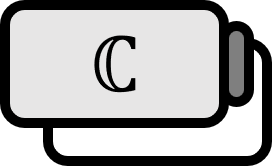Definition of Complex Numbers
Definition 1
- The solution $x = \sqrt{-1}$ of the quadratic equation $x^{2} +1 = 0$ is called an Imaginary Number.
- A number in the form of $z = x + iy$ for two real numbers $x,y \in \mathbb{R}$ is called a Complex Number, and is also denoted as $(x,y)$. Here, $\operatorname{Re} (z) = x$ and $\operatorname{Im} (z) = y$ are called the Real Part and Imaginary Part of $z$, respectively.
- The set of all complex numbers is denoted by $\mathbb{C}$. Two complex numbers $z_{1}, z_{2} \in \mathbb{C}$ are said to be Equal when their real parts and imaginary parts are respectively equal. $$ \operatorname{Re} z_{1} = \operatorname{Re} z_{2} \\ \operatorname{Im} z_{1} = \operatorname{Im} z_{2} $$
- The magnitude of a complex number is called the Modulus and is defined as follows. $$ | z | := \sqrt{x^{2} + y^{2}} $$
Explanation
- Note that the imaginary part $\operatorname{Im} z = y \in \mathbb{R}$ is not multiplied by the imaginary unit $i$.
- In physics and engineering, since $i$ represents current, the imaginary unit is sometimes denoted as $j := \sqrt{-1}$.
- In the curriculum, complex numbers are commonly indicated as $1 + 2i$ with $i$ written after the number, but in mathematics-oriented literature, the tendency is strong to denote it as $1 + i2$ with $i$ in front. This indicates the intention to treat $i$ not as a letter but as a number equal to any other, and it can be understood that this notation is practical as it makes the front the real part and the back the imaginary part around $i$.
History
Historically, the imaginary number was first introduced in Ars Magna, a work by Cardano (a pioneer of probability theory) in 1545. It was not fully accepted in the mathematical community until about the 19th century. Gauss named $i$ as Imaginary Number, the current term, and used it in the proof of the Fundamental Theorem of Algebra. The symbol $i$ itself appears in Euler’s memoir of 1777.
Complex Plane 2
$$ \mathbb{C} \ni x + iy = (x,y) \in \mathbb{R}^{2} $$
As can be guessed from the definition, the set of complex numbers $\mathbb{C}$ can be seen as, and actually corresponds to, a two-dimensional plane $\mathbb{R}^{2}$. Literally, $x$ represents the $x$ axis, and $y$ represents the $y$ axis, which will now mean the real axis and imaginary axis, respectively. It is very logical that the modulus of a complex number is defined as $| z | := \sqrt{x^{2} + y^{2}}$ when considering Pythagoras’ Theorem.
Field Axioms
$$ \begin{align*} z_{1} + z_{2} =& \left( \operatorname{Re} z_{1} + \operatorname{Re} z_{2} , \operatorname{Im} z_{1} + \operatorname{Im} z_{2} \right) \\ z_{1} \cdot z_{2} =& \left( \operatorname{Re} z_{1} \operatorname{Re} z_{2} - \operatorname{Im} z_{1} \operatorname{Im} z_{2} , \operatorname{Re} z_{1} \operatorname{Im} z_{2} - \operatorname{Im} z_{1} \operatorname{Re} z_{2} \right) \end{align*} $$
If the binary operations Addition $+: \mathbb{C}^{2} \to \mathbb{C}$ and Multiplication $\cdot: \mathbb{C}^{2} \to \mathbb{C}$ for two complex numbers $z_{1}, z_{2} \in \mathbb{C}$ are defined as above, then $\mathbb{C}$ algebraically becomes a Field, and $\mathbb{C}$ is called the Complex Field. Similar to the Real Field in introduction to analysis, all field axioms are satisfied.
